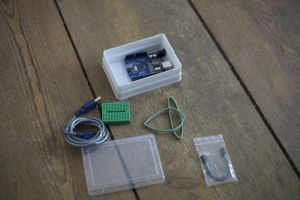| Line 28: | Line 28: | ||
==Tutorials== | ==Tutorials== | ||
*Max/MSP/Jitter https://docs.cycling74.com/max7/ | *Max/MSP/Jitter https://docs.cycling74.com/max7/ | ||
*Max 7 Tutorial #1 - # | *Max 7 Tutorial #1 - #7: https://www.youtube.com/watch?v=xRd0-giLGPM&list=PLVIa8UkRzErsdnC1DEpDy7S9Ss7BhY7nY | ||
*Max/MSP/Jitter video tutorials http://federicofoderaro.com/videoTutorials.html | *Max/MSP/Jitter video tutorials http://federicofoderaro.com/videoTutorials.html | ||
Revision as of 20:22, 23 April 2020
Lecturer: Mindaugas Gapševičius
Credits: 6 ECTS, 2 SWS
Date: Wednesdays, 17:00-18:30
Venue: Marienstraße 7b, Raum 204
First meeting: Wednesday, 6th of May 17:00-18:30
The course will focus on the development of simple interactive applications, which will foster the imagination of interaction mechanisms between computational machines and the world. To bridge the physical world and computers, we will use Arduino microcontrollers and to trigger the world we will use Max/MSP/Jitter visual programming language.
In the first half of the semester, students will be expected to develop weekly tasks. The tasks will include programming data exchange between devices, data conversion between sound, image, and text, data sensing, and frameworks influencing the physical world. Along with the work in our home offices, we will use Moodle webinar, GMU Wiki, and online tutorials for learning programming with Max. The second half of the semester will be devoted to the realization of the individual idea.
No special skills are required to participate in the course. The necessary tools are provided.
Tools and a toolkit
- Arduino microcontroller
- light sensor
- LED
- jumper cables (3 units)
- breadboard
Tutorials
- Max/MSP/Jitter https://docs.cycling74.com/max7/
- Max 7 Tutorial #1 - #7: https://www.youtube.com/watch?v=xRd0-giLGPM&list=PLVIa8UkRzErsdnC1DEpDy7S9Ss7BhY7nY
- Max/MSP/Jitter video tutorials http://federicofoderaro.com/videoTutorials.html
Please Note
This class is limited to students from BfA/MfA MKG, VK, FK, Media Architechture
Grading
The outcome of the course is an interactive setting between computers and environments. The successful completion of the course is a regular participation in the Moodle webinar and a project documented in the GMU wiki. The documentation may contain text, video, images, sketches, sound and other digital formats.
- 20 % Work in class
- 50 % Individual project
- 30 % Documentation including 20% of updates in Wiki


